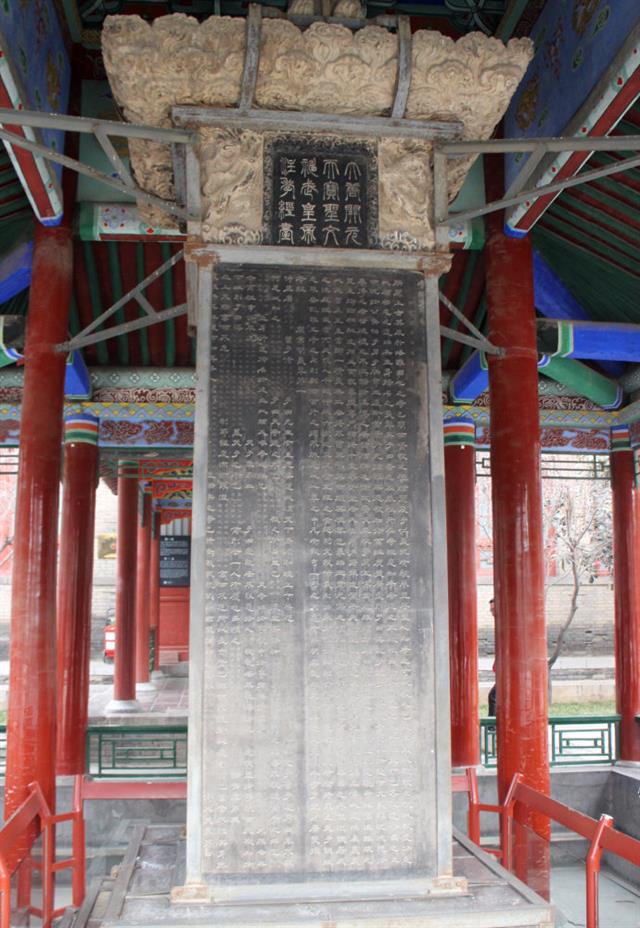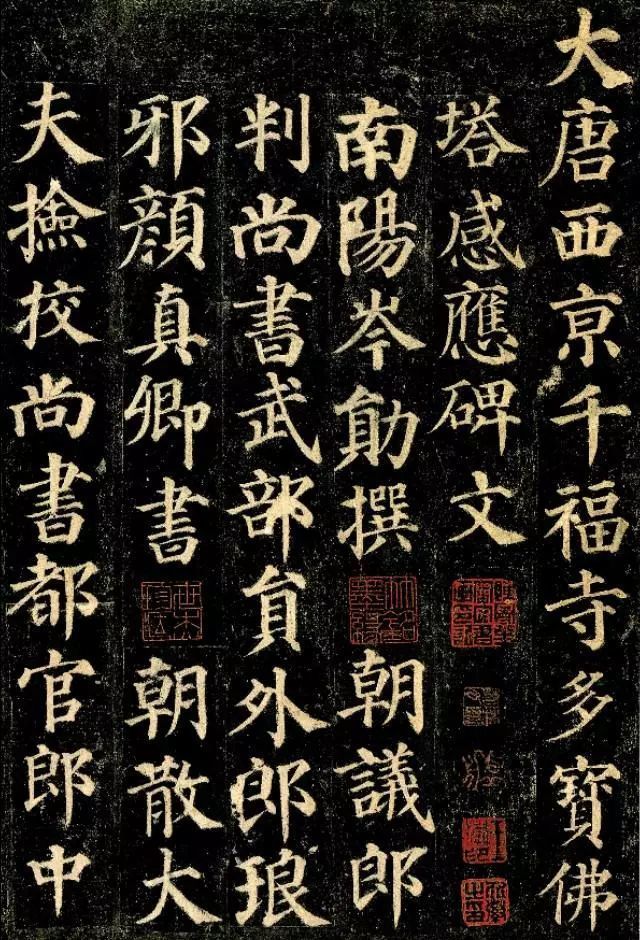
当前课程知识点:陕西导游英语 > 1. 美景篇 > 1.3 The Forest of Stone Tablets 西安碑林博物馆 > 1.3 Text 讲解词


Hello, everyone! Today we are going to visit a famous museum, the Forest of Stone Tablets. The Forest of Stone Tablets Museum is a courtyard-styled structure and covers an area of about 30, 000 square meters. It is situated on the site of the Confucian Temple on Sanxue Street, Xi'an. The museum served as the Imperial Ancestral Temple in the Tang Dynasty, and later became the Confucian Temple in the Song Dynasty. In 1950, it was extended into the museum that greets us today.
The highlights of the museum of course mainly refer to the stone tablets and stone sculptures. But there are some others that might attract your interest. For example, decorated memorial arch or pailou in Chinese, it was set up to honor men of attainments in ancient times. The structure aheadof us is the so called pailou.
If we move on, we can see some stone stakes that can date back to Ming and Qing Dynasties.
Besides the pailou and stone stakes, we can aslo see a big bell housed in the eastern pavilion. The bell was cast in 711 A.D. and was accepted as a world famous bell at the World Bell Exhibition in 1964. A recording of its chimes ia played by the Central People’s Broadcasting Station on New Year’s Eve to usherin the New Year.
Now the main course of our visit, the stone tablets and stone scultures.
The exhibits here can be divided into two categories: stone tablets and stone sculptures. The treasure house comprises a large collection of centuries-old stone tablets. Over 3,000 stone tablets from the Han Dynasty through the Qing Dynasty are preserved, hence its name the"Forest of Stone Tablets.” The Forest of Stone Tablets is not only a treasure house of ancient Chinese calligraphy, but also a rich collection of historical documents and stone carvings of various styles. The Forest of Stone Tablets was declared a top-priority national historical monument by the State Council in March, 1961.The tablets bear evidence to the cultural achievements recorded in ancient China and the cultural exchanges between China and other countries. No tourists will take the risk of missing the Forest of Stone Tablets once they visit Xi'an.
The stone tablets are now on display in seven display rooms, six epitaph corrdors and one tablet pavilion. Let’s visit them one by one.
In front of the first display room is the Tablet Pavilion specially built for the Classic On Filial Piety.”
“The Classic on Filial Piety”is the largest stone tablet in the Forest of Stone Tablets. It was engraved after the handwritten copy of Emperor Xuan Zong(Li Longji) in745A.D.. The classic was compiled by Zeng Shen, a disciple of Confucius after he attended his teacher's lecture on filial piety. Emperor Xuan Zong wrote a preface to the classic in the hopes that the country would be governed on the principle of filial piety.The preface is followed by the body of the classic.The small characters are Emperor Xuan Zong's annotations to the classic.
The First Display Room
The first display room houses the“Kaicheng Stone Classics,”including 12 Chinese classics, namely“The Book of Changes, ”“The Book of History, ”etc. The classics, with a total number of 650, 252 characters, were engraved double-sided on 114 stone tablets.The display room also houses another classic entitled“Mencius, ”with 30, 000 characters, which was engraved on 17 stone tablets in the Qing Dynasty. This Classic and 12 others are called the“Thirteen Classics.”These 12 classics were required readings for feudal society intellectuals. Printing was quite backward in ancient times. The classics were engraved on stones as the standard copy so that they could be well kept and men of letters could avoid errors in copying them. The stone tablets were then erected in the Chang'an Imperial Academy for the proof-reading of handwritten copies. From the Eastern Han Dynasty onwards, the classics were engraved seven times. However, only the “ Kaicheng Stone Classics”remain intact today.
The Second Display Room
This display room mainly houses the stone tablets of calligraphy written by famous calligraphers of the Tang Dynasty. Up to today, these tablets have served as models for learners of calligraphy to follow. Several examples are the“Tablet to Huangfu Dan”by OuyangXun, the“Tablet to Master Dao Yin”by Ouyang Tong, the son of Ouyang Xun the“Tablet to Duobao Pagoda”and the“Tablet to the Yan's Ancestral Temple” by Yan Zhenqing the”Tablet to the Mysterious Pagoda”by Liu Gongquan,(P11,共2张) and the world famous“the Nestorian Tablet.”
The Third Display Room
The third display room houses the stone tablets that range from the Han Dynasty to the Song Dynasty. They bear a wide variety of Chinese script forms, including seal script, official script, regular script, running script and cursive script, these stone tablets show the evolution of the Chinese writinng system.
The Fourth Display Room
This display room houses works of poetry in authentic handwriting of the well-known calligraphers from the Song through the Qing Dynasty, tablets of historical significance in the Ming and Qing Dynasties, and some line engravings from the Song through the Qing Dynasties. Here are two line engravings: “Bodhidharma’s Eastbound Journey” and Bodhidharma in Meditation”.
This drawing is composed of characters ingeniously pieced together. It is called Jizi Kuixing Diandou Tu (a portrait of Kuixing composedof characters). The man's posture implies that he ranks first on the list of successful candidates.This picture is vividly and ingeniously constructed.
The Fifth Display Room
The fifth display room houses the stone tablets which record such historical facts as temple repair, canal digging and wall mending during the dynasties of Song, Yuan, Ming and Qing. They provide valuable data of reference for the study of feudal society and local history.
There are also some tablets inscribed with big characters written in a single stroke by Ma Dezhao in the Qing Dynasty. They include“虎”,“寿 and“福” which literally mean in English, tiger”,”longevity” and ” happiness. ” The characters assume a vigorous style and offer much enjoyment to their viewers.
The Sixth Display Room
The sixth display room mainly houses stone tablets of poetry and verses that date back to the dynasties of Yuan, Ming and Qing. Typical examples are “A Visit to Mt. Tianguan” by Zhao Mengfu of the Yuan Dynast, “Farewell to Zhang Sheng in Muoling Inn” by Dong Qichang of the Ming Dynasty, “A letter to Wu He” by Emperor Kang Xi of the Qing Dynasty in Mi Fu's writing style (P32) and “A Visit to Mount Hua” by Lin Zexu. They are all treasures of the country.
The Seventh Display Room
This last display room was built in 1982, and houses “the Secret Court Copybook of Chunhua” in the Song Dynasty.The secret copybook is made up of ten volumes. The first five volumes contain the works of calligraphy in seal script, cursive script and regular script. They were created by famous emperors,ministers and calligraphers in anciet times.The other five volumes contain the works of Wang Xizhi and Wang Xianzhi in cursive script.They are a collection of the works of the Chinese calligraphers before the Song Dynasty.
The Corridors of Epitaphs
Along the six tortuous corridors, there are epitaphs from the Wei to the Qing Dynasties. In the Wei and Jin periods, it was strictly forbidden to hold extravagant funerals for the dead and erect memorial tablets before their tombs, but to commemorate the deceased, their families and relatives engraved on the stone tablets words of compliment for the dead and placed the tablets secretly into their tombs. This type of stone engraving later gave rise to the emergence of epitaphs.
The Stone Scuplture
This showroom was built in 1963. It houses more than 70 stone sculptures which were originally collected from different parts of Shaanxi Province. These pieces of art are classified into two groups: mausoleum carvings and religious carvings. They are arranged in chronological order. Because of our tight schedule , I just want to introduce two stone sculptures. First, Zhaoling Mausoleum Horeses.
When Zhaoling was built by the order of Emperor Li Shimin, six stone horses were also sculpted in memory of the six horses, which had served him in constant wars. They were actually created by the famous painter Yan Liben.
,and the last two were stolen and now are stored in America.
This is a statue of Li Er, the founder of the theory of Taoism,a religion of the Han nationality. The religion originated from the late Eastern Han Dynasty. The statue was probably created by Yuan Jia' er, a famous sculptor from the Western Regions. This work of art is one of the masterpieces among the Tang-Dynasty sculptures.
-1.1 Emperor Qinshihuang’s Mausoleum Site Museum 秦始皇帝陵博物院
--1.1 Test 测试
-1.2 Shaanxi History Museum 陕西历史博物馆
--1.2 Test 测试
-1.3 The Forest of Stone Tablets 西安碑林博物馆
--1.3 Test
-1.4 Xi’an City Wall 西安城墙景区
--1.4 测试
-1.5 The Huaqing Hot Spring 华清池景区
--1.5 测试
-1.6 The Big Wild Goose Pagoda 西安大雁塔
--1.6 测试
-1.7 The Tang Paradise 大唐芙蓉园
--1.7 测试
-1.8 The Great Mosque 西安清真大寺
--1.8 测试
-1.9 Famen Temple Buddhist Cultural Scenic Area 陕西法门寺佛文化景区
--1.9 测试
-1.10 The Yellow Emperor’s Mausoleum 黄帝陵景区
--1.10 测试
-1.11 Yan’an Revolutionary Heritage Site 延安革命纪念地景区
--1.11 测试
-1.12 Mount Huashan 华山风景名胜区
--1.12 测试
-1.13 Jinsi Grand Canyon Scenic Spot 金丝峡景区
--1.13 测试
-1.14 Taibaishan International Holiday Resort 太白山国际旅游度假区
--1.14 测试
-2.0 Prelude 引言
-2.1 Diced Pancake Boiled in Mutton & Beef Soup 羊肉泡馍
--2.1 Test 测试
-2.2 Xi'an Dumpling Banquet 饺子宴
--2.2 Test 测试
-2.3 Biang Biang Noodles 扯面
--2.3 Test 测试
-2.4 Pancake Stuffed with Marinated Pork 肉夹馍
--2.4 Test 测试
-2.5 Cold Noodles with Sesame Paste 麻酱凉皮
--2.5 Test 测试
-3.1 Shaanxi Local Specialties 陕西特色手工艺品
--3.1 Test 测试
-3.2 Qin Terracotta figures 兵马俑复制品
--3.2 Test 测试
-3.3 Stele Rubbings and Yaozhou Green ware 拓片和耀州瓷
--3.3 Test 测试
-3.4 Leather Shadow Puppets and Paper Cuts 皮影和剪纸
--3.4 Test 测试
-3.5 Shuyuanmen Cultural Street 书院门
--3.5 Test 测试
-4.1 The Tang Dynasty Music and Dance Show 仿唐乐舞
--4.1 Test 测试
-4.2 The Song of Everlasting Sorrow Evening Show 长恨歌
--4.2 Test 测试
-4.3 The Great Tang All Day Mall 大唐不夜城
--4.3 Test 测试
-5.1 Meeting with a Tour Group at the Airport 机场接机
--5.1 Test 测试
-5.2 Welcome Speech 欢迎词
--5.2 Test 测试
-5.3 Brief Introduction to Shaanxi and Xi’an 陕西及西安简介
--5.3 Test 测试
-5.4 On the Way to the Hotel 去钟楼饭店途中
--5.4 Test 测试
-5.5 Check in at Bell Tower Hotel 钟楼饭店入住
--5.5 Test 测试
-5.6 Discuss the Itinerary 讨论行程安排
--5.6 Test 测试
-5.7 Change the Room 调换房间
--5.7 Test 测试
-5.8 Arrange the Morning Call 安排叫早
--5.8 Test 测试
-5.9 On the Way to the Scenic Spot 去景点途中导览
--5.9 Test
-5.10 Having a Meal 用餐
--5.10 Test 测试
-5.11 Watching the Song of Everlasting Sorrow Evening Show 看《长恨歌》实景演出
--5.11 Test 测试
-5.12 Shopping 购物
--5.12 Test 测试
-5.13 Check Out 结账离店
--5.13 Test 测试
-5.14 Seeing the Tourists Off 机场送别
--5.14 Test 测试
-期末考试

